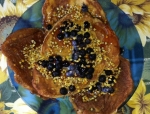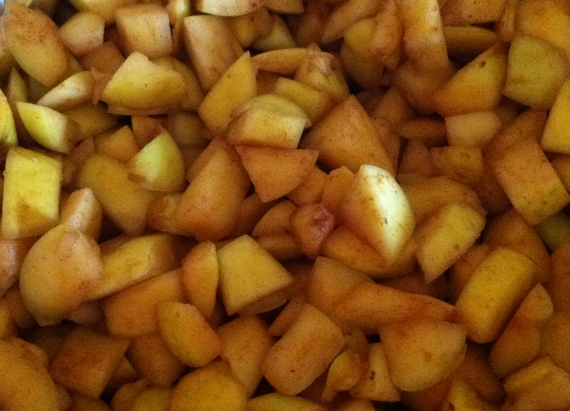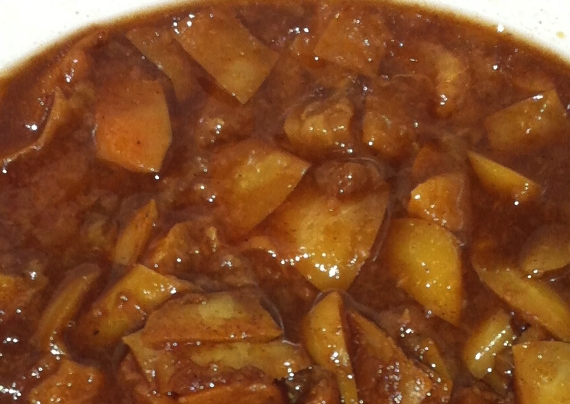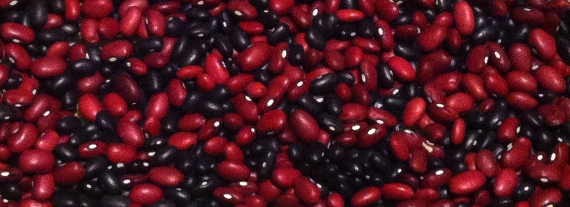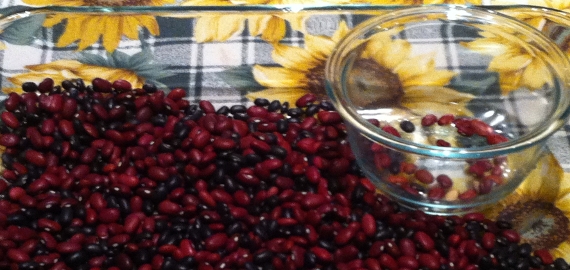Almond Flour Pancakes
My husband and I love almond pancakes, especially since they are tasty, versatile and gluten-free. The original recipe was not vegan, but I included egg-less options in the recipe below to make some pancakes with either “chia eggs” or “flax eggs.” We have tried out a few different versions of gluten-free pancakes, including the buckwheat pancakes from Kelly E. Keough’s Sugar-Free Gluten-Free Baking and Desserts and the mixed gluten-free flour pancakes in Kelli and Peter Bronski’s Artisanal Gluten-Free Cooking.We like this one best, so much so that I’m sharing it with you!
A while ago, we completely ran out of almond meal, which meant no more pancakes or almond flour-based foods. When I bought almonds, I kept forgetting to set aside some for making flour and we just kept snacking on them instead. Oops. This meant no almond milk either. Our focus had changed I suppose; we were eating and drinking other things instead. I really missed making my almond pie crusts and almond pancakes though. Thankfully, a friend’s family has a bakery-cafe that is only about a 15 to 20 minute drive away. We hadn’t been down to visit in a while, but was on the way to another friend in a series of theatrical performances, which provided a great excuse to go. We had a nice lunch, good catch-up chat, delicious gluten-free cookies and bought a few pounds of almond flour, too. The performances were pretty good and the plots rather moving. All in all it was a great day!
I insisted that we make pancakes the following day. I could wait no longer. Since we hadn’t made them in a while, we had to make quite a few adjustments as we were going along, tweaking the batter consistency, pan temperature and cook times. It was quite a challenge between the two of us, but we figured it out with only a few getting burned. I had forgotten to write down my recipe alterations from the last time we cooked them. Oh well, so now I am writing them down here for you and for my own reference later. For curiosity’s sake, if you have your own food blog, how often do you go back and remake the food from your recipe entries? What have you remade?
My hubby likes his pancakes rather plain with blue agave and Earth Balance spread, but I top mine with coconut oil (which provides a satisfying crunch once it cools), fresh or frozen berries, warm compote (like apples, pears or quince), pie spices, bee pollen, and blueberry or raspberry blue agave or dark amber grade A or B maple syrup, depending on my mood. Vegan homemade chocolate and nut butter chips would be tasty on top, too. I am curious to find out what eating the pancakes with a bit of molasses, ginger and apples would taste like, since molasses contains a boat load of vitamins and minerals. Has anyone tried this?
How do you make your pancakes? What do you top them with? Do you like to make special shapes? Do you try to sneak in extra vitamins? If so, how?
Almond Pancakes
Adapted from Elana Amsterdam’s The Gluten-Free Almond Flour Cookbook. The batter from the original recipe was too thick, like cake batter, so I thinned it out to prevent burning.
Yields 15 Pancakes
Ingredients
2 Eggs
Or 2 Chia or Flax Seed Eggs (2 T Ground Seeds + 6 – 10 T Filtered Water)
1/4 C Blue Agave Nectar
1 T Vanilla Extract*
1/2 C Filtered Water or as needed
1 1/2 C Almond Flour
1/2 tsp Himalayan Sea Salt
1/2 tsp Baking Soda
1 T Arrowroot Powder
Grape Seed Oil
Optional Toppings
Coconut Oil or Earth Balance Spread
Agave Nectar, Maple Syrup, Honey or Fruit preserves
Fresh or Frozen Fruit
Hemp, Flax Seeds, Sunflower or Other Seeds
Crushed Walnuts, Pecans, Almonds, etc.
Ground Cinnamon, Carob, Cacao, Pie Spices
Bee Pollen
Gluten-Free Granola
Directions
In a food processor, beat the eggs. If you are making vegan pancakes with the ground chia or flax seed eggs, mix the seed meal with water in a small bowl and set aside for 15 to 20 minutes, adding more water if necessary to obtain an egg-like consistency.
In the processor, mix together the eggs, agave, extract and water on high for 1 minute. Mix in the flour, salt, baking soda and arrowroot until thoroughly combined.
In a large oiled pan over low or a little above low heat, spoon one tablespoon full of batter. Quickly spread out the batter with the edge or backside of the spoon to speed up the cooking time and ensure even cooking. Once bubbles form on the top of the batter through the bottom of the pancake, lift the edges off the pan with a spatula before flipping it over. If you just try to flip the cake over, it can squish together into a heap, depending on the thickness of pancake. Cook the other side thoroughly. Transfer the pancake to a plate and place in the oven (or microwave) to keep warm. Continue to cook the remaining batter into pancakes. Serve with desired toppings.
*You can substitute the extract with the scraped out seeds of 1 – 2 vanilla beans.
Note: If you like, you can add the nuts, seeds, fruit or spices to the batter rather than put them on top.



